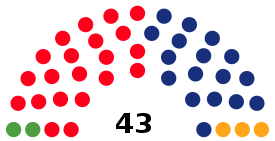1987 Barcelona City Council election
The 1987 Barcelona City Council election, also the 1987 Barcelona municipal election, was held on Wednesday, 10 June 1987, to elect the 3rd City Council of the municipality of Barcelona. All 43 seats in the City Council were up for election. The election was held simultaneously with regional elections in thirteen autonomous communities and local elections all throughout Spain, as well as the 1987 European Parliament election.
| |||||||||||||||||||||||||||||||||||||||||||||||||||||||||||||||||||||||||||
All 43 seats in the City Council of Barcelona 22 seats needed for a majority | |||||||||||||||||||||||||||||||||||||||||||||||||||||||||||||||||||||||||||
|---|---|---|---|---|---|---|---|---|---|---|---|---|---|---|---|---|---|---|---|---|---|---|---|---|---|---|---|---|---|---|---|---|---|---|---|---|---|---|---|---|---|---|---|---|---|---|---|---|---|---|---|---|---|---|---|---|---|---|---|---|---|---|---|---|---|---|---|---|---|---|---|---|---|---|---|
| Opinion polls | |||||||||||||||||||||||||||||||||||||||||||||||||||||||||||||||||||||||||||
| Registered | 1,342,049 | ||||||||||||||||||||||||||||||||||||||||||||||||||||||||||||||||||||||||||
| Turnout | 925,036 (68.9%) | ||||||||||||||||||||||||||||||||||||||||||||||||||||||||||||||||||||||||||
| |||||||||||||||||||||||||||||||||||||||||||||||||||||||||||||||||||||||||||
| |||||||||||||||||||||||||||||||||||||||||||||||||||||||||||||||||||||||||||
Electoral system
The City Council of Barcelona (Catalan: Ajuntament de Barcelona, Spanish: Ayuntamiento de Barcelona) was the top-tier administrative and governing body of the municipality of Barcelona, composed of the mayor, the government council and the elected plenary assembly. Voting for the local assembly was on the basis of universal suffrage, which comprised all nationals over eighteen, registered in the municipality of Barcelona and in full enjoyment of their political rights, as well as resident non-nationals whose country of origin allowed Spanish nationals to vote in their own elections by virtue of a treaty.[1][2][3]
Local councillors were elected using the D'Hondt method and a closed list proportional representation, with a threshold of 5 percent of valid votes—which included blank ballots—being applied. Parties not reaching the threshold were not taken into consideration for seat distribution.[1][2][3] Councillors were allocated to municipal councils based on the following scale:
| Population | Councillors |
|---|---|
| <250 | 5 |
| 251–1,000 | 7 |
| 1,001–2,000 | 9 |
| 2,001–5,000 | 11 |
| 5,001–10,000 | 13 |
| 10,001–20,000 | 17 |
| 20,001–50,000 | 21 |
| 50,001–100,000 | 25 |
| >100,001 | +1 per each 100,000 inhabitants or fraction +1 if total is an even number |
The mayor was indirectly elected by the plenary assembly. A legal clause required that mayoral candidates earned the vote of an absolute majority of councillors, or else the candidate of the most-voted party in the assembly was to be automatically appointed to the post. In case of a tie, a toss-up would determine the appointee.[3]
The electoral law provided that parties, federations, coalitions and groupings of electors were allowed to present lists of candidates. However, groupings of electors were required to secure the signature of a determined amount of the electors registered in the municipality for which they sought election. For the case of Barcelona, as its population was over 1,000,001, at least 8,000 signatures were required. Electors were barred from signing for more than one list of candidates. Concurrently, parties and federations intending to enter in coalition to take part jointly at an election were required to inform the relevant Electoral Commission within ten days of the election being called.[1][2]
Opinion polls
The table below lists voting intention estimates in reverse chronological order, showing the most recent first and using the dates when the survey fieldwork was done, as opposed to the date of publication. Where the fieldwork dates are unknown, the date of publication is given instead. The highest percentage figure in each polling survey is displayed with its background shaded in the leading party's colour. If a tie ensues, this is applied to the figures with the highest percentages. The "Lead" column on the right shows the percentage-point difference between the parties with the highest percentages in a given poll. When available, seat projections are also displayed below the voting estimates in a smaller font. 22 seats were required for an absolute majority in the City Council of Barcelona.
| Polling firm/Commissioner | Fieldwork date | Sample size | Turnout | IC | Lead | |||||||
|---|---|---|---|---|---|---|---|---|---|---|---|---|
| 1987 municipal election | 10 Jun 1987 | N/A | 68.9 | 43.6 21 |
35.5 17 |
– | [lower-alpha 3] | 5.2 2 |
2.3 0 |
7.6 3 |
3.4 0 |
8.1 |
| Sigma Dos/Diario 16[p 1] | 4 Jun 1987 | ? | ? | ? 19/21 |
? 14/16 |
– | [lower-alpha 3] | – | – | ? 5/6 |
? 2/3 |
? |
| DYM/Cambio 16 | 4 Jun 1987 | ? | ? | ? 21/23 |
? 13/14 |
– | [lower-alpha 3] | – | ? 1/2 |
? 2/4 |
? 2/3 |
? |
| ABC[p 2] | 2 Jun 1987 | ? | ? | ? 20/22 |
? 17/19 |
– | [lower-alpha 3] | – | – | ? 3/5 |
– | ? |
| Central de Campo/PSC[p 3] | 1–2 Jun 1987 | 800 | ? | ? 23/24 |
? 14/15 |
– | [lower-alpha 3] | – | – | ? 3/4 |
? 2 |
? |
| Demoscopia/El País[p 4] | 22–26 May 1987 | ? | 68 | 32.9 15 |
33.6 16 |
– | [lower-alpha 3] | 2.8 0 |
5.9 2 |
15.5 7 |
7.7 3 |
0.7 |
| DYM/La Vanguardia[p 5] | 27–29 Apr 1987 | 1,001 | ? | 46.8 23 |
29.1 14 |
– | [lower-alpha 3] | 4.2 0 |
2.7 0 |
7.6 3 |
6.8 3 |
17.7 |
| Line Staff/CiU[lower-alpha 4][p 6] | 4–10 Apr 1987 | 1,478 | ? | 39.1 | 30.0 | – | [lower-alpha 3] | 2.7 | 1.2 | 2.3 | 2.8 | 9.1 |
| CIS[p 7] | 25 Mar–5 Apr 1987 | 802 | ? | 48.6 25 |
29.5 15 |
– | [lower-alpha 3] | – | – | 5.8 3 |
– | 19.1 |
| 1986 general election[4] | 22 Jun 1986 | N/A | 67.4 | 34.4 18 |
34.1 18 |
14.7 7 |
[lower-alpha 5] | 3.1 0 |
4.9 0 |
[lower-alpha 6] | 4.2* 0 |
0.3 |
| 1984 regional election[5] | 29 Apr 1984 | N/A | 64.4 | 26.4 13 |
49.0 25 |
10.3 5 |
5.0 0 |
4.7 0 |
– | [lower-alpha 6] | – | 22.6 |
| 1983 municipal election | 8 May 1983 | N/A | 67.4 | 45.8 21 |
27.4 13 |
13.0 6 |
6.9 3 |
3.9 0 |
0.9 0 |
[lower-alpha 6] | – | 18.4 |
| (*) Results for Union of the Catalan Left. | ||||||||||||
Results
 | ||||||
| Parties and coalitions | Popular vote | Seats | ||||
|---|---|---|---|---|---|---|
| Votes | % | ±pp | Total | +/− | ||
| Socialists' Party of Catalonia (PSC–PSOE) | 400,280 | 43.61 | –2.19 | 21 | ±0 | |
| Convergence and Union (CiU) | 325,463 | 35.46 | +8.09 | 17 | +4 | |
| People's Alliance (AP)1 | 69,419 | 7.56 | –5.42 | 3 | –3 | |
| Initiative for Catalonia (IC)2 | 47,406 | 5.16 | –2.83 | 2 | –1 | |
| Democratic and Social Centre (CDS) | 31,028 | 3.38 | +2.44 | 0 | ±0 | |
| Republican Left of Catalonia (ERC) | 21,236 | 2.31 | –1.55 | 0 | ±0 | |
| Green Alternative–Ecologist Movement of Catalonia (AV–MEC) | 3,916 | 0.43 | New | 0 | ±0 | |
| Ecologist Party of Catalonia–VERDE (PEC–VERDE) | 3,116 | 0.34 | New | 0 | ±0 | |
| Workers' Party of Spain–Communist Unity (PTE–UC) | 2,078 | 0.23 | New | 0 | ±0 | |
| Spanish Phalanx of the CNSO (FE–JONS) | 1,388 | 0.15 | +0.02 | 0 | ±0 | |
| Revolutionary Workers' Party of Spain (PORE) | 1,152 | 0.13 | +0.03 | 0 | ±0 | |
| Republican Popular Unity (UPR)3 | 1,069 | 0.12 | +0.03 | 0 | ±0 | |
| Humanist Platform (PH) | 948 | 0.10 | New | 0 | ±0 | |
| Communist Unification of Spain (UCE) | 869 | 0.09 | New | 0 | ±0 | |
| Internationalist Socialist Workers' Party (POSI) | 636 | 0.07 | New | 0 | ±0 | |
| Social Democratic Party of Catalonia (PSDC) | 566 | 0.06 | New | 0 | ±0 | |
| Communist Workers' League (LOC) | 428 | 0.05 | New | 0 | ±0 | |
| People's Democratic Party (PDP) | 0 | 0.00 | New | 0 | ±0 | |
| Blank ballots | 6,879 | 0.75 | +0.32 | |||
| Total | 917,877 | 43 | ±0 | |||
| Valid votes | 917,877 | 99.23 | +0.87 | |||
| Invalid votes | 7,159 | 0.77 | –0.87 | |||
| Votes cast / turnout | 925,036 | 68.93 | +1.51 | |||
| Abstentions | 417,013 | 31.07 | –1.51 | |||
| Registered voters | 1,342,049 | |||||
| Sources[6][7][8][9] | ||||||
Notes
- Data for AP–PDP–UL in the 1983 election.
- Aggregated data for PSUC and PCC in the 1983 election.
- Within IC.
- Undecided and/or abstentionists excluded.
- Within UEC.
- Within AP–PDP–UL/AP–PDP–PL.
References
- Opinion poll sources
- "Algunas encuestas electorales plantean un descenso exagerado del PSOE". ABC (in Spanish). 5 June 1987.
- "Maragall puede perder". ABC (in Spanish). 2 June 1987.
- "La última encuesta socialista da la mayoría absoluta al PSC en Barcelona". La Vanguardia (in Spanish). 4 June 1987.
- "Maragall puede perder la alcaldía en beneficio de Cullell" (PDF). El País (in Spanish). 4 June 1987.
- "Los sondeos de PSC y CIU discrepan sobre el resultado electoral en Barcelona". La Vanguardia (in Spanish). 10 May 1987.
- "Los socialistas podrían gobernar con mayoría absoluta". La Vanguardia (in Spanish). 8 May 1987.
- "Un sondeo del CIS para el Gobierno da la mayoría del PSOE en Madrid y Barcelona" (PDF). El País (in Spanish). 4 June 1987.
- Other
- "General Electoral System Organic Law of 1985". Organic Law No. 5 of 19 June 1985. Official State Gazette (in Spanish). Retrieved 28 December 2016.
- "Representation of the people Institutional Act". www.juntaelectoralcentral.es. Central Electoral Commission. Retrieved 16 June 2017.
- "Regulation of the Basis of Local Regimes Law of 1985". Law No. 7 of 2 April 1985. Official State Gazette (in Spanish). Retrieved 27 August 2017.
- "Electoral Results Consultation. Congress. June 1986. Barcelona Municipality". www.infoelectoral.mir.es (in Spanish). Ministry of the Interior. Retrieved 12 November 2017.
- "Election Results. Parliament of Catalonia Election 1984". gencat.cat (in Catalan). Generalitat of Catalonia. Retrieved 12 November 2017.
- "Election Results. Municipal Elections 1987. Barcelona". gencat.cat (in Catalan). Generalitat of Catalonia. Retrieved 12 November 2017.
- "Local election results, 10 June 1987" (PDF). www.juntaelectoralcentral.es (in Spanish). Central Electoral Commission. Retrieved 16 February 2018.
- "Electoral Results Consultation. Municipal. June 1987. Barcelona Municipality". www.infoelectoral.mir.es (in Spanish). Ministry of the Interior. Retrieved 12 November 2017.
- "Municipal elections in Barcelona since 1979". historiaelectoral.com (in Spanish). Electoral History. Retrieved 30 September 2017.
_Felipe_Gonz%C3%A1lez_recibe_al_alcalde_de_Barcelona._Pool_Moncloa._20_de_septiembre_de_1989_(cropped)_(cropped).jpeg)
